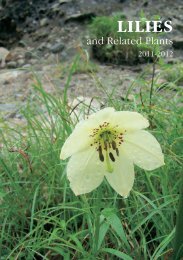LILIES - RHS Lily Group
LILIES - RHS Lily Group
LILIES - RHS Lily Group
Create successful ePaper yourself
Turn your PDF publications into a flip-book with our unique Google optimized e-Paper software.
G. granulosa Turcz.<br />
Perennial. Among steppe shrubs, edges of light forests. Environs of stanitsa Ust-<br />
Buzulikskaya and stanitsa Nekhaevskaya (Sagalaev, 2000). Meadow-steppe plants.<br />
Seldom. Fl. IV-V.<br />
G. minima (L). Ker-Gawl.<br />
Perennial. Steppe slopes, edges of upland woods and shrubby thickets in steppe<br />
ravines, rarified forests and forest belts. Rather seldom (near khutors Ozhogin and<br />
Shakin, between khutors Krivsky and Pustovsky, near stanitsa Ust-Buzulukskaya and<br />
other places). Edge of wood-woody-steppe plants. Fl. IV-V.<br />
G. podolica Schult. et Schult. fil.<br />
Perennial. On chalk hills, steppe slopes, glades and edges of woods, in rarified forests,<br />
between birch groves, on saline soils, overgrown sand, banks of reservoirs. Very<br />
common. Edge of wood-steppe plants. Fl. IV-V.<br />
G. pusilla Schult. & Schult. fil.<br />
Perennial. Steppe, slopes of ravines. It has not been found in the Park. but V.V. Fedyaeva<br />
(2004) is of the opinion that it is common in the adjacent Sholokhovsky district of<br />
Rostov region. Edge of wood-steppe plants. Fl. III-IV. Apparently it was stated for the<br />
Volgograd region by mistaken identity.<br />
Tulipa biebersteiniana Schult. et Schult. fil. s.l.<br />
Perennial. Woods, slopes of steppe ravines, shrubby thickets, glades and edges of forest.<br />
Quite common. Edge of wood-woody-steppe plants.<br />
In the territory of the Park there are several different forms related to T. biebersteiniana.<br />
So, in Shakinskaya Dubrava a white flowering form occurs, which was once identified<br />
as a separate species, T. patens Agardh. ex Schult. & Schult. f. (Sagalaev, 2006b). Tulipa<br />
patens was identified in the Nekhaevsky district (Kuvaldina, 1982). We discovered it<br />
in a small glade, numbering several dozen plants, growing together; it was a pale<br />
yellow flowering form. The flowers were of nearly the same shape as the typical<br />
T. biebersteiniana, but of another colour. They have white petals, with yellow centre,<br />
and pinkish tips. Besides, in more shady and wet places another form was found,<br />
with larger flowers, hooked and bending inflorescenses before flowering, rather large<br />
bulbs which produce stolons. In many characteristics these plants may be united with<br />
real Tulipa sylvestris L. At chalk hills and saline places one finds another form – these<br />
are low plants with narrow glaucous leaves and upright inflorescences. Earlier it was<br />
described as T. scythica Klok. & Zos. The real status of these forms is not clear for us at<br />
present and requires further investigation.<br />
T. schrenkii Regel (T. gesneriana L.)<br />
Perennial. Open slopes of steppe ravines, chalk hills. It prefers hard clay, salty or<br />
carbonate soils. Seldom (near stanitsas Ust-Buzulukskaya, Bukanovskaya, Fedoseevskaya<br />
etc.). Steppe plants. It has become a very rare plant due to ploughing up of virgin<br />
steppe and mass picking for bunches of flowers. Nowadays it does not produce the<br />
same spectacle as in former times, when it made complete red-yellow fields. Yellow<br />
flowers may be found much more seldom than red ones (according to literature data<br />
they may also be white). The flowers may,or not, have black or yellow spot in the<br />
middle (near the base of petals); petals being acuminate or more seldom obtuse. Bulbs<br />
are situated much deeper in the ground than those of other tulips.<br />
Introduced and cultivated Liliaceous plants<br />
Some decorative species of local flora are cultivated in gardens and orchards<br />
at stanitsas Bukanovskaya, Kumilzheskaya and other small and large Cossack<br />
120




